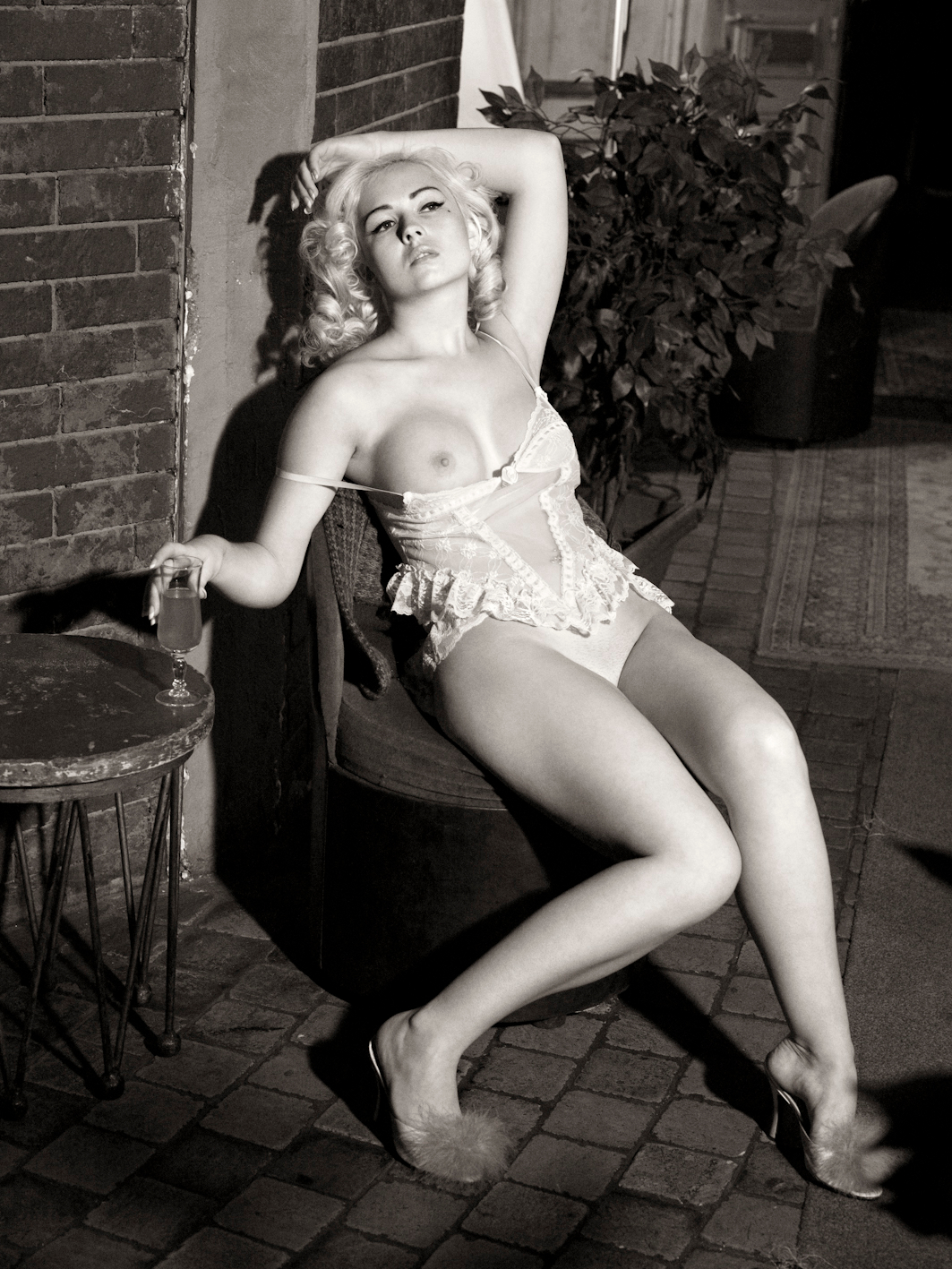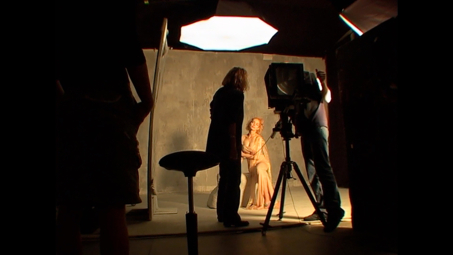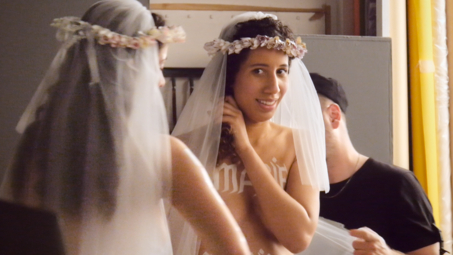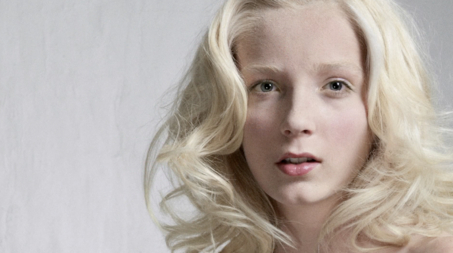Fragments : an interview with Bettina Rheims
Bettina Rheims talks to Emmanuel Bacquet about her inspirations, her creative process and her artistic evolution. Learn how her projects, from the Gender Studies series to portraits of incarcerated women, reflect a growing commitment and an ongoing quest to capture the essence of her subjects, transcending the conventions of photography.
***
Emmnauel Bacquet: You have photographed women a lot, though not exclusively, and what is striking is the way the markers appear jumbled in your pictures. There's no apparent classification between stars and unknowns, between commissioned photos and those taken outside of any campaign.
The even-handed treatment of stars and unknowns, and these blurred lines between commercial projects and your personal research, have marked your work.
In your more recent projects Gender Studies, Détenues, and Naked War with the Femen, we feel a detachment from the commission, from fashion, from luxury, from glamour, to an orientation that’s much more committed. Is this correct?
Bettina Rheims: Yes, it's probably more visible – I have worked for 40 years; at first, I didn't imagine photography as a possible occupation, a profession. I began by taking photographs out of curiosity, for my pleasure, developing them, – I loved the printing process! – I could spend whole nights in the lab under the red light, before storing my prints in boxes. And the rest of the time I had another job.
Then one day, I changed my approach, thanks to the benevolent (not always!) support of Helmut Newton, who was my master and who introduced me to his agent, I began to earn a living taking photographs to order...
Amidst all these commissioned photos, there's always THE photo: the one that hooks you, the one you immediately spot on the contact sheet; sometimes it's one or two in a series, sometimes more.
These seemed to go way beyond one publication, or a campaign in a magazine.
So I took them out of the commissioned folder to make works of them.
I smuggled them past the concrete wall (which was then almost impassable) between "art" and "commerce".
This did me quite a disservice: museum people would say, "She works for magazines; that's vulgar!" while magazine people were more: "Yes, but she's an artist. It'll be hard to get her to work.
This confusion over the status of the image – whether commercial or artistic – has always been my way of working. Things have changed a bit since, fortunately, the wall is much more porous, but back in the 1990s it was very confusing.
And if you look among my most iconic photos, very often they started off as "just" commissioned pictures.
Throughout my career I've always enjoyed working on both aspects: I've used commissions as a laboratory for more personal projects.
I was in the studio virtually every day for a year, two years. We'd do session after session; we earned a reputation. When I wanted to do a personal project, as soon as we could finance it, we'd switch to voicemail and take off!
When the project was finished, it became a book, or an exhibition... Then we came back to paid work.
It must be said that, back then, when we had a commission, we had the means, technically, to experiment with new things, and the chance to work with the best: the best hairdressers, stylists and makeup artists, whom I would then hire for other projects.
Then, little by little, I ended up thinking that the world of commerce no longer needed me.
I was doubtless shaken by the arrival of digital technology, as now taking photographs involved no real need for "know-how", especially about lighting.
And if posting photos on Instagram was the ultimate goal, then I wasn't interested.
At the same time, the stars began to be surrounded by managers – "image managers" – which changed the relationship and the spontaneity. You had to take into account contracts with brands banning them from doing one thing and requiring them to do another. So I saw all this creativity with famous people that I had enjoyed for decades fade further and further away.
Until one day, when I decided that my personal projects interested me more, and that I would gradually take on no more orders.
In the end, it wasn't that gradual; just when I didn't want it anymore, the customers didn't need me anymore... Now, more or less anyone can take photos!
And then the budgets also shrank: I financed my personal work mainly from the studio's profits, except for the very large projects, for which I was lucky enough to have sponsors.
I have often worked as they do in the movies: when you have a producer and a backer, you can work for a very long time on a film and spend a lot of money. I was lucky to have major sponsors for personal projects, whether for I.N.R.I., for Shanghai, for Rose, c’est Paris... These projects were put together like movie productions. I'm probably one of the only photographers to have had the opportunity to produce my work like this.
EB: But don't the brands and sponsors also need and even expect very personal artistic work?
BR: Yes, expectations were high: to walk through the door to my studio was to want that singular aspect of my work, not just a well-known name or because I was "bankable", but to be able to approach my world, emotions, fantasies...
I had a lot of freedom. With today's censorship – what we're allowed to do and not allowed to do – there are pictures I could no longer make now. I'd be pilloried straight away.
EB: In the end it was also a way of finding a form of freedom and independence, breaking with commercial photography? This desire to avoid cliché, to resist any form of recovery, is that fundamental for you?
BR: Yes, indeed. For example, I'm always asked if I'm a feminist. Of course I am, but I've never needed to express that publicly in words: my work speaks for itself!
I've loved strong and fragile women, women apart. It's also true that I'm a woman and I require a certain complicity with my models.
Sometimes I'm asked if I have any tricks. What's my secret? I have none and I think we all have the same tools. I use the same tools as everyone. Then it's about that relationship you have to establish with someone you've never seen who will make the picture. Someone who will open the blue studio door, with whom we'll spend the day. Someone in whom we'll have to find joy, sadness, emotion... It's this alchemy that grips me, that gives me a sense of the rightness of the images we make together.
EB: There's a particular intensity within the closed doors of the studio and in the staging. Is there also an "analyst's couch" aspect in your relationship with the model?
BR: People often talk to me during the shoots, sometimes they just keep on talking and I talk back to them.
You have to imagine the scene; I am not seen when I'm photographing; I'm hidden, half behind the camera, so it's my voice that guides them.
I soon realised that I couldn't be silent, that the moment I fall silent, I lose the tie that binds us: the model in front and me behind the camera.
From that place, with this tension, I've captured all these wonderful things that these women have given me over time.
EB: Talking of psychoanalysis, there is also the disturbing strangeness of Freud and surrealism which creates a particular tension in Rose, c’est Paris?
BR: Rose, c’est Paris, a project that I conceived with the help of Serge Bramly, is actually the story of our journeys, of our childhoods.
We were both raised in Paris, more or less in the same neighbourhoods, but didn't know each other. Twenty years on, we found out that our little sisters were in the same class in primary school. So we were very close, totally unaware of each other, but geographically close with the same images in our heads. Rose, c’est Paris is a double tribute to that time, the meeting of a city at the very beginning of the 20th century and the advent of surrealism, which has always inspired me.
We went back to the writings of André Breton and Fantômas (which is a totally surrealist novel) and the adventures of this mysterious criminal hero of popular literature written by Pierre Souvestre and Marcel Allain.
We needed a narrative; Rose, c’est Paris, would be a story with Paris as a backdrop, twin sisters, the hypothesis of a disappearance, a frantic search for the missing Rose that would take us to shady places... a story that would also be the story of our families.
And we used our memories to make it into a story in photos.
It also answered my question of whether you could tell a story in photos without falling into the "photo novel" category.

L'heure creuse, January 2009, Le Magic, boulevard de Clichy, Paris © Bettina Rheims
EB: And the mention of Marcel Duchamp?
BR: The presence of Duchamp is a strong contribution from Serge, who knows his work very well and has written a book on it: we interwove our obsessions, which fit together well.
The film and the photos answer each other: Serge had a video camera, I had a stills camera. I took my photos and he filmed. The only proviso in our "terms and conditions" was that he stayed out of shot of my camera. After a very long preparation, we unfolded the scenes and discovered some unlikely places.
In 2010, we put on the exhibition Rose, c’est Paris at the Bibliothèque nationale de France in the rue Richelieu. I was very fond of that exhibition. There were thirteen chapters, and each chapter had a different room.
In each room there was a passage from the film next to the corresponding photos.
That was an exciting exhibition.
EB: On the work that followed, and the Gender Studies series, there's this reflection on gender that corresponds to a societal evolution, "gender fluidity", we find ourselves facing another form of tension: that of a desire that no longer fits established patterns.
BR: I began this work in 1986.
At a random casting that I was doing for an advertisement, a boy showed up with long hair, Christ-like and a little feminine, and later on a young girl who had the face of a little boy.
I put the two Polaroids from the casting side by side, and felt something was happening.
Modern Lovers marks the beginning of this reflection. We were then at the heart of the tragedy of the Aids years. Even as the virus was obliterating any possibility of sexuality, I meet a new generation, very young people from 15 to 18, who no longer want to be qualified or conform to the binary of the male/female gender; I discover their powerful desire to play their seduction games elsewhere, somewhere nearby...
At the same time, Jean-Paul Gaultier was choosing very androgynous models for his shows.
That was in 1986, and since then I haven't stopped working on the issue of gender: I did some work on transsexuality, in particular with my friend Kim Harlow.
I then put that research aside for twenty years until one day I picked it up again and wondered where we had got to. I then put an ad on Facebook...
(I must admit I was still wondering what Facebook could be used for: I had never posted my private moments, I didn't look at other people's private moments either; I'm not interested).
So I put a post on Facebook that went like this: "I am Bettina Rheims, I did Modern Lovers. If you feel different from the rest, come and see me."
Modern Lovers had been a huge success, the book had been reprinted more than five times, it really did reveal something strong.
I had lots of responses from all over the world!
That was the starting point for Gender Studies.
For this project, I partnered with a sound artist called Frédéric Sanchez. He had installed a sound cabin next to the studio, and after the shoot the models would join Frédéric and he'd record their testimony.
He created a very beautiful sound piece where voices that vibrate between the masculine and the feminine are mixed and answered.
EB: The film Gender Studies, which we are presenting here, is indeed really special: the mixture of the texture of the voice and the texture of the skin... it's a very tactile film.
BR: Absolutely! In the exhibition, which was made up of square rooms, there was this sound in the middle of each square room and all these intermingled voices…
EB: There were harder series too: the Detained, Naked War, with the Femen, here your work is aiming for a certain roughness.
BR: For over ten years my work has been becoming more political, but everything since then has become overtly political, it must be said.
The Detained series was an upheaval.
For years, Robert Badinter (with whom I am lucky enough to occasionally lunch) kept pushing me. He'd say, "Bettina you must go to prison to see these women behind bars". I resisted for a long time out of fear, not knowing how to tackle the issues of punishment, confinement, and being a woman in these places where your eyes and your freedom are taken away.
It became imperative!
In 2014 after months of exchanges and negotiation, I finally obtained the permission and the support of the prison administration to organise within each establishment photo shoot sessions with women who had volunteered.
I went to meet these women who hadn't made the choice to live within four walls. We talked a lot. They told me about themselves, and I tried to give them a moment away from that time.
Some portraits were presented at La Maison Européenne de la Photographie during my retrospective exhibition in 2016.
In 2018 the series became an installation that brought together more than fifty portraits. The exhibition, which met with great success, was hosted in very different venues – at the Sainte-Chapelle de Vincennes, Château de Cadillac near Bordeaux, converted in the 19th century into a "school for the preservation of young girls" where young minors who were considered delinquent were sent. Last year it was presented at the Friche la belle de Mai in Marseille. Editions Gallimard, touched by the project, did me the honour of publishing the book in their La Grande Blanche collection.
Naked War with the Femen activists in a certain way prolongs my engagement after the Detained project.
I found out about their actions through a television documentary.
Inna Shevchenko, a major figure of Femen was interviewed; I was fascinated: They were more than a body. They had a constructive and powerful message. I wanted to meet them to understand how they put their bodies on the line as a political tool. They invented the "political nude".
After several meetings, heated discussions to dispel our fears, they agreed to join me on this project. It became a very engaged and political time.
They had asked me not to have them pose in a "girly" way, and of course there was no question of me hijacking their words and actions.
Over a whole week we did this series of portraits, a minimal space just on a white background, a plinth like a paving stone, and these militant women who came from all over: Paris, Berlin, Madrid, Montreal, Stockholm.... It was really very joyful, very strong and very powerful at the same time!
EB: Did you also use their own phrases and slogans?
BR: Of course, they're their words written on their bodies, sublimated by the work of this incredible makeup artist, Topolino…
EB: How do you work? Do you have a favourite team?
BR: I owe a lot to the makeup artist, Topolino; I owe him the Christs of I.N.R.I., the beautiful makeup of Rose c’est Paris, his work with the Femen I mentioned, and the incredible work on Héroïnes...
It's people like him who have accompanied me all my life and who don't get enough credit. I'm thinking of that incredible hairdresser David Mallet. I made my best pictures with him!
They have been with me through all my periods: the commercial work, my personal work, travelling abroad... It's my team, people with whom I've often spent more time than with my family!
I do work that is developed by teamwork. I've never walked around on my own with a camera. Besides I don't have one. The ones I use are stored somewhere at the studio.
I develop my photos with my collaborators, it's a construction, like a canvas, like a sculpture.
Everything is thought out in advance, and everything is ready down to the smallest detail, be it a hairstyle, the dress, the panties that the young woman will wear, the light that we talked about before.
Then, when I arrive on set, it's up to me to administer the kick to fire up the beautiful machine and produce the picture.
It doesn't work every time; sometimes it's just a pretty photo, sometimes it's much more than that.
EB: Do you need to totally trust your team on set?
BR: Yes, if someone breathes too heavily it can bother me! The people around me know that this is a silent set, they don't leap on a model to change the hairstyle or a detail; they only step in when I say so. It's like a tête-à-tête but isn't one really.
When the models arrive at the door, they're not the same as when they enter the set. All the waiting, the makeup, the hairdressing that precedes it is the airlock, the preparation time that allows you to build that feeling of trust.
It's an important time for me too: when Kate Winslet arrives at the studio at 7 a.m. I still don't know her, even though I've seen all her films.
We need to have this time to get to know each other.
EB: Can even stars who are very used to the camera feel slightly fragile in front of your lens?
BR: Yes, absolutely, fragility is part of the game: we need it. I even use this fragility!
EB: Talking of teams, do you have a regular printer?
BR: For thirty years Choï has been my very close collaborator: not one picture would exist without Choï seeing it and testing it... Unfortunately he stopped working ten years ago following an accident. But he was my "other pair of eyes": together we built the final image; he was always in the studio.
EB: Which project are you currently working on?
BR: I still can't say... but you'll know soon!
Interview conducted in May 2021
Translated from French by Henry Moon
Notes:
Choï: Choï Chung Chun was born in Hong Kong in 1949 and began his apprenticeship by assisting his photographer uncle. The teenager who dreamed of becoming a painter arrived in Paris in 1965 to enrol at the Ecole des Beaux-arts. He had just turned just 16. He was 19 when he started work in a laboratory, where he perfected his printing skills until becoming a specialist in large format. Described as exceptional and brilliant, there Choï receives his photographic clients, with whom he maintains a friendly and unique working relationship. (from Choï's biography by Hervé Le Goff)
Cover photo credits :
Madonna laying on the floor of a crummy hotel room in a Lacroix dress, September 1994, New York© Bettina Rheims




